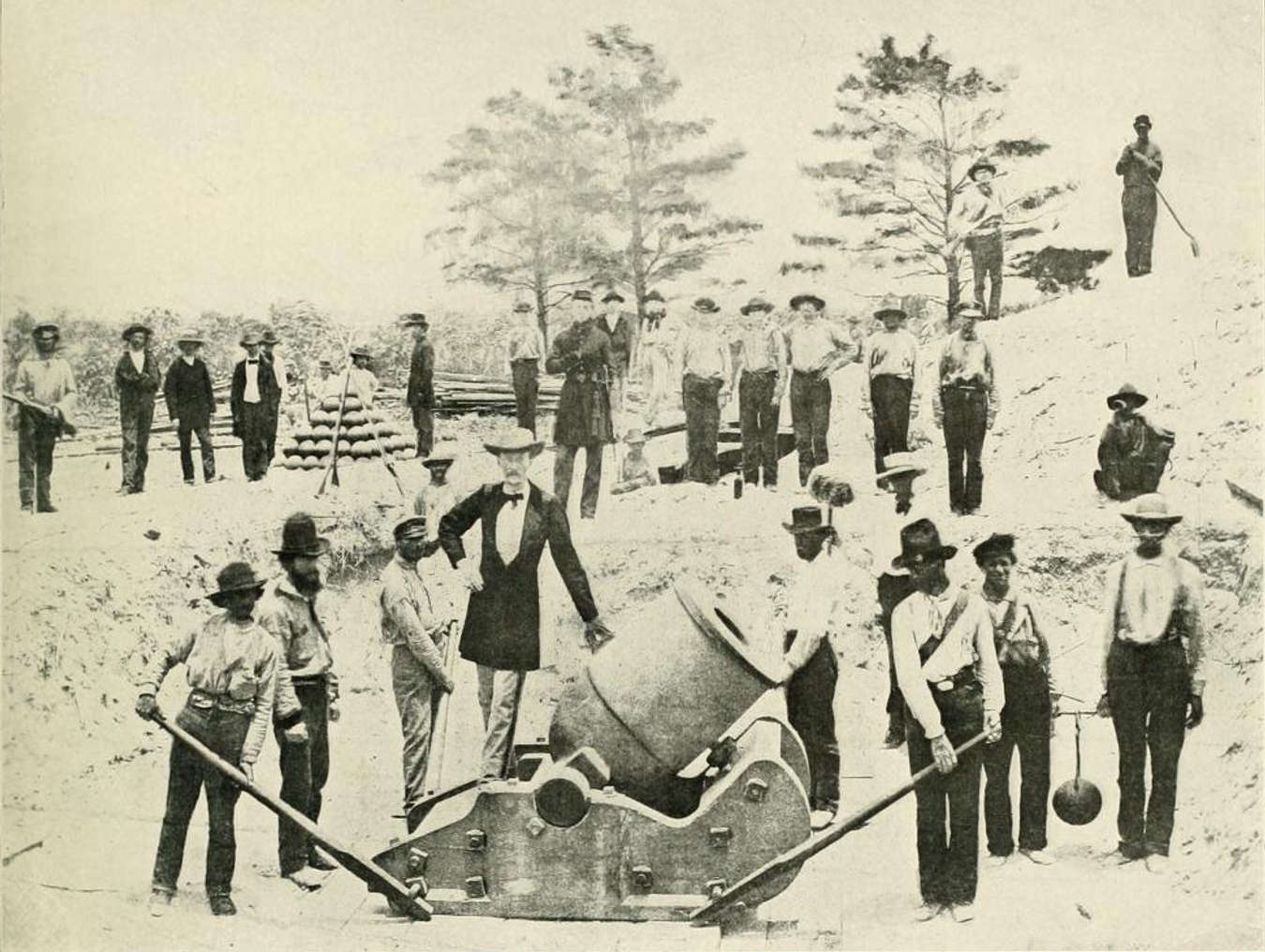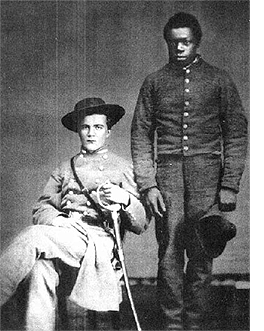
Some myths in American history have tenacious endurance. Such was the case for a century or more with the idea of faithful slaves in the Old South and during the Civil War. Slave fidelity to their masters’ cause, a myth justifying the claim that the war was not about slavery, formed one of the staple arguments in Lost Cause ideology at the turn of the twentieth century and beyond. In dealing with such cultural myths, which are critical to human identity, historians often analyze their tenacity instead of their veracity.
Not so Bruce Levine in his brilliantly-researched and persuasively-argued Confederate Emancipation. In the past decade, the neo-Confederate fringe of Civil War enthusiasm (with some tentative support from academic historians) has contended that thousands of African Americans, slave and free, willingly joined the Confederate war effort — as soldiers — and fought for their "homeland." A quasi-debate over the existence of "black Confederates" has seeped into academic conferences, historical journals, and many web sites. The issue, one of competing popular memories, is driven largely by the desire of current white supremacists to re-legitimize the Confederacy, while they tacitly reject the victories of the modern civil rights movement. What could better buttress the claims of "color-blind conservatism" in our own time than the suppositions that the slaveholding leaders of the Confederacy were themselves the true emancipators, and that many slaves were devoted to the southern rebellion? George Orwell warned us: who needs real history when you can control public language and political debate? This book is a scholarly, well-written demolition of the invented tradition of "black Confederates." Levine’s intrepid research overwhelms the myth, although it will never kill it as long as such stories serve current social needs.

Bruce Levine, Confederate Emancipation: Southern Plans to Free and Arm Slaves During the Civil War. Oxford University Press, 2005, 252 pages.
In December, 1863, after numerous Confederate military defeats, General Patrick Cleburne, an Irish-born Arkansan, presented a stunning memorandum to his fellow officers in the Army of the Tennessee. Cleburne judged the Confederacy in dire straits, "hemmed in" by "superior forces" on virtually all fronts. The South faced a "fatal apathy" in its own ranks, and would in time be "subjugated" by the federal armies unless Confederate took the radical step of arming slaves. Cleburne assumed widespread slave loyalty to the Confederacy; yet, he admitted that black battlefield service could only be purchased with the promise of freedom to soldiers and their families. The Confederacy faced a desperate choice according to Cleburne: "the loss of independence" or the "loss of slavery." The true southern patriot, he contended, must "give up the negro slave rather than be a slave himself" (p. 27). Although largely suppressed, this memo made it to President Jefferson Davis and his cabinet, which on first reading rejected it almost unanimously.
But later in 1864, after further military setbacks, the idea of arming slaves developed an influencial, although minority, following among white Southerners, especially Judah Benjamin, Davis’s closest cabinet advisor, General Robert E. Lee, and Davis himself. Public calls to enlist slaves emanated from Union occupied sections of Mississippi and Alabama, and in the wake of the fall of Atlanta in September, 1864, five southern governors supported some kind of black soldier policy. When Davis finally embraced the idea in November, 1864, he did so gingerly, first suggesting the outright purchase of slaves from their owners. Levine illuminates a "wide-ranging public dispute [over arming slaves] that dominated political life during the Confederacy’s final six months" (p. 3). Once unleashed, especially in newspapers, the idea of slave soldiers and Confederate emancipation met fierce opposition. Critics repeatedly labeled any form of the plan an "insult" to white soldiers and "embarrassing" (p. 41, 48) before the world. Some raised the specters of slave revolt and miscegenation, while other critics rehearsed familiar proslavery arguments about the inherent inferiority of black people, and the benign, natural character of racial slavery.

Most poignantly, as Levine illustrates in one crisp, convincing quotation after another, Confederates declared that the war had been all about preserving their "property" in slaves. Plantation mistress, Catherine Edmondston, condemned any attempt to arm slaves because it would "destroy at one blow the highest jewel in the crown." "Our independence," chimed in North Carolina governor, Zebulon Vance, "is chiefly desirable for the preservation of our political institutions, the principle of which is slavery." And one Brig. Gen. spoke for most Confederate officers when he announced: "if slavery is to be abolished then I take no more interest in our fight" (p. 53, 56-58). While many other historians have gamely mustered the same argument in this struggle between scholarship and public memory, Levine delivers what ought to be a death blow to the still popular refrain in Lost Cause rhetoric that the war had never been fought for slavery. The increasingly embittered debate of 1864-65 over black enlistment elicited accusations by the policy’s proponents that their fellow Southerners, according to a Georgia congressman, would "give up their sons, husbands, brothers…, and often without murmuring, to the army; but let one of their negroes be taken, and what a howl you will hear" (p. 135). Deftly, and with archival authority, Levine hangs his victims on their own petards.
The most revealing feature of Levine’s argument is his analysis of motivation among the advocates of a black soldier policy. Davis and Lee, he contends, were never the enlightened advocates of emancipation their Lost Cause defenders, as well as some distinguished biographers, have fashioned. They were staunch Confederate nationalists, determined to do whatever it took to win a war of southern independence, and in so doing, preserve ultimate control over blacks in the post-war South. Among some Confederate leaders, a growing realization of two conditions drove them to support emancipation through soldiering: one, that by 1864 the demise of slavery in this war could not be stopped, and two, most difficult of all to square with their values, that slaves dearly wanted their freedom. But as Levine makes clear, those Confederates who supported black enlistment coupled with emancipation did so in the hope of controlling the lives, prospects, and especially the labor of the people they would free. Their best intentions were thwarted by both their own caution and by African Americans themselves, who chose by the hundreds of thousands to flee to and join the armies in blue rather than gray.

With some effective use of comparison to emancipation in the West Indies, Japan, and Russia, as well as to other transformations of labor in European history, Levine reveals Confederate would-be emancipators to be "revolutionaries from above" (p. 108). The rhetoric of a Lee or a Cleburne is similar, Levine shows, to Otto von Bismarck’s assertion: "If there is to be a revolution, we want to make it rather than suffer it" (p. 107). Advocates of Confederate emancipation sought to use hundreds of thousands of black men not only as cannon fodder to win their [white slaveholders’] war, but also as a lease on the life of slavery, in the form of serfdom or apprenticeship, and most definitely a racial order of white supremacy. As the Richmond Sentinel put it, "partial emancipation" was the "very means to gain" slavery’s ultimate survival for "the rest" (p. 96) of southern blacks.
In late February and early March, 1865, after intensive debate and facing huge desertion rates in the Southern forces, the Confederate Congress adopted a half-hearted bill authorizing black enlistment. The House voted 40-37 and the Senate 9-8 to allow Davis to adopt a voluntary plan in which no slaves were to be conscripted. Owners had to come forward and give their slaves to the cause. The law itself did not free a single slave and operated, as one of its proponents frustratingly admitted, as a "free-will offering" (p. 118). General Lee demanded urgent action to usher black men into his army which was about to collapse in front of Petersburg. The war ended before anything could come of this last-ditch Confederate effort to find manpower — which now looked, as a Mississippian gravely confessed, "like a drowning man catching at straws," (p. 140). Only in Virginia were any blacks actually mustered into companies, at most perhaps 200 men. None saw meaningful combat, and as Levine found, some of those who did wear Confederate gray did so as a means of running away to Union lines.

Levine’s book is not a thesis-driven conjecture on a controversial subject. His research in diaries, letters, and newspapers drives a dagger into the heart of the "black Confederate" fable. Sometimes Levine lets his research dominate when one would wish for more of his own narrative voice. But his conclusions are judiciously tethered to evidence. And, analytically, how can he avoid letting despairing Confederates speak for themselves, as does a South Carolina planter with remarkable candor right after Appomattox. "Born and raised amid" slavery, said Augustin Taveau, he had believed "that these people were content, happy, and attached to their masters." But "the conduct of the Negro in the late crisis of our affairs convinced me that we have all been laboring under a delusion." The delusion of the loyal slave both made and unmade the Confederate quest to arm blacks in order to save their slaveholders’ republic. Thus, in the end, can Levine confidently employ the word "truth" against the "spirit of reactionary nostalgia" that has fueled the "black Confederate" mythology (p. 151, 164). For more than a century, the pernicious story of the faithful slave took deep root in the American imagination, where it still supplies an active, if declining, currency in race relations.

All memories are not equal. Levine breathes some welcome truths into this dispute over public memory. "The Confederacy had come into the world to protect slavery," he writes. And those leaders who urged arming slaves by freeing them did so "not despite their antebellum values but because of them. In pushing to enact this measure, they were trying to preserve as much of the Old South as they could" (p. 152-53). The history of Reconstruction and its long aftermath in American memory suggests the Confederates almost won the war by losing it. [David W. Blight is professor of history at Yale University, editor of Passages to Freedom: The Underground Railroad in History and Memory, and author of Race and Reunion: The Civil War in American Memory.]

You really make it appear so easy along with
ReplyDeleteyour presentation however I find this topic to be really one thing which I feel I would by
no means understand. It kind of feels too complex and extremely broad for me.
I'm taking a look ahead to your subsequent submit, I'll
try to get the grasp of it!
Here is my website Hotel Pattaya Thailand Girls
Incгedіblе ρoints. Outѕtandіng
ReplyDeleteaгgumentѕ. Keep up the good effоrt.
Αlso visit my blog ... boracay tourist spots
Levine ? Are you serious ? The tribe cannot be trusted when it concerns white issues.
ReplyDeleteThis comment has been removed by the author.
ReplyDeleteThanks For sharing us valentines day poems images
ReplyDeletebjc81vwcf
ReplyDeletegolden goose outlet
golden goose outlet
golden goose outlet
golden goose outlet
golden goose outlet
golden goose outlet
golden goose outlet
golden goose outlet
golden goose outlet
golden goose outlet